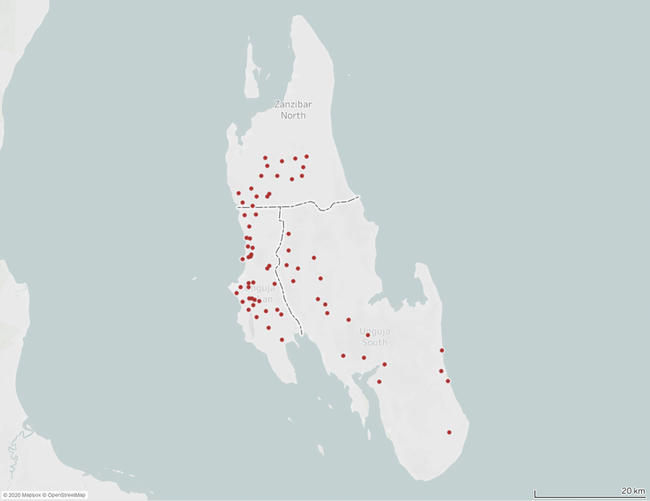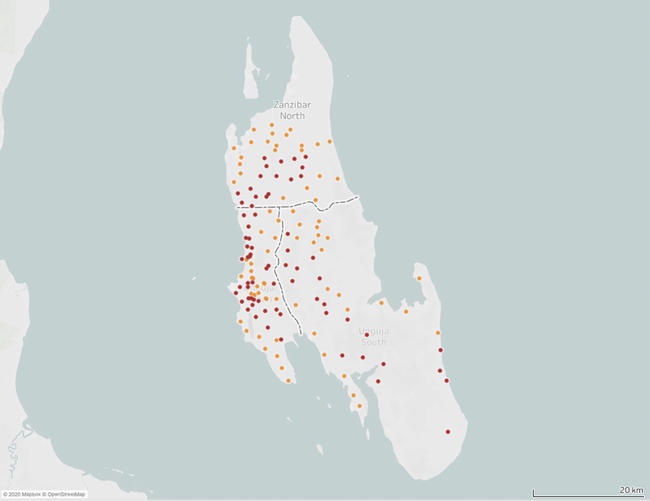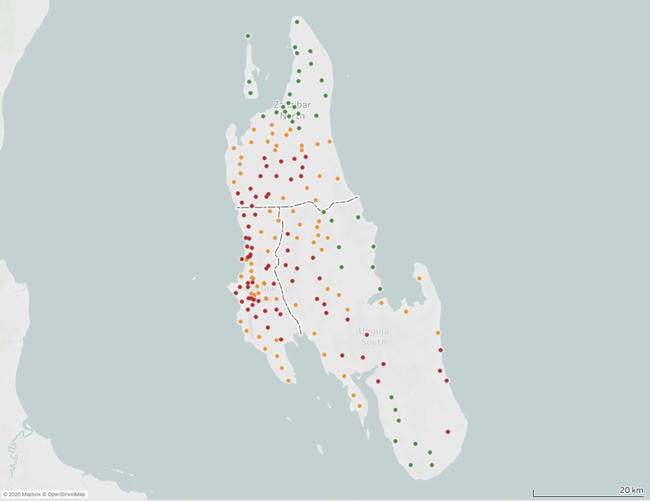
Strategic Vaccination: Unguja Island, Zanzibar
Start: August 2017
End: December 2018
Duration: 16 months
-
71% decrease in animal rabies-positive cases
-
6,174 dogs vaccinated
-
Estimated vaccination coverage of 50%
-
13 vaccinators became AVC graduates
- Department of Livestock Development, Zanzibar
- World Animal Protection
Concept
Mass dog vaccination relies on vaccinating approximately 70% of the entire dog population. While this approach is known to be effective, it is often unachievable in resource-limited settings due to logistical and resource constraints.
Strategic dog vaccination relies on identifying rabies hotspots (high-risk areas) and directing vaccinators to vaccinate these dog populations. Therefore, rather than vaccinating 70% of the entire dog population, strategic dog vaccination relies on vaccinating approximately 70% of the at-risk dog population. The ability to implement strategic dog vaccination relies on the ability to rapidly detect and report rabies cases (Rabies Case Surveillance component of the REB) and the ability to track and monitor vaccinations within the at-risk dog populations (GARC Data Logger or Rabies Vaccination Tracker component of the REB).
Strategic dog vaccination relies on identifying rabies hotspots (high-risk areas) and directing vaccinators to vaccinate these dog populations.
Strategic dog vaccination is an approach that interrupts disease spread in a way that is resource friendly, while also being quick and effective.
Project Description
As a first step towards implementing the strategic vaccination campaign, rabies hotspots (areas at high risk of rabies or where cases were detected) were identified across the island.
Laboratory data was entered into the RCS component of the REB, which automatically generated the most up-to-date maps. These maps were used to identify the villages where rabies cases occurred. Once the hotspots had been identified, a plan was developed to guide the vaccinators to each of the hotspots (and their surrounding villages) in order to target all of the high-risk areas in a relatively short period of time.

The strategic plan relied on a phased approach where hotspots were first targeted. The campaign would then expand from every different hotspot in a wave-like manner, growing from the centre of each hotspot outwards to ensure that all rabies transmission cycles were broken.
After the first round of vaccination across the island, the case data was reviewed, and a plan was developed to guide the vaccinators to the villages bordering the high-risk areas. These villages were considered to be “middle risk” as they were further away from the hotspots. This would be considered the “second wave” of vaccinations.
Strategic dog vaccination relies on the ability to rapidly detect and report rabies cases.
If a rabies case was detected during this phase of the campaign, vaccinators were immediately directed to the village where the rabies case was identified another round of vaccination. This immediate intervention took place within 48 hours to ensure that the new rabies transmission cycle could immediately be broken without spreading.

After the second round of vaccination, case data was once again reviewed. The case data was near real-time as laboratory staff would immediately submit case data onto the system. Therefore, new cases and hotspots could be identified on a daily basis. In the last phase of the strategic vaccination approach, “low-risk” villages on the island were targeted.
Once again, any new rabies cases that were detected during this phase of the campaign resulted in the vaccinators immediately being directed to the village for dog vaccination within 48 hours. Once the newly detected hotspot had been vaccinated, the third round of the campaign progressed as planned.

Outcome
Over a 16-month period, a relatively small vaccination team consisting of 13 members vaccinated 6174 dogs and 457 cats at selected vaccination sites across the island. While the estimated vaccination coverage of the entire dog population on the island was only 50%, the number of rabies-positive cases in animals had decreased by 71% (28 rabies cases in 2017 vs. 8 rabies cases in 2018). In addition, the strategic vaccination campaign also successfully eliminated rabies from the majority of the island, with the remaining few cases largely being limited to the high-density urban settlements situated along the western coast of the island. These areas will be targeted in the next round of vaccination to ensure that all of the rabies transmission cycles are broken, and rabies eliminated from the island.
Most importantly, the strategic vaccination approach targeted both owned and unowned dogs. This is essential as unowned or stray dogs also pose a risk and can maintain a cycle of rabies, later transmitting it to owned dogs.